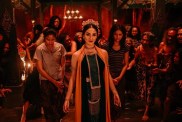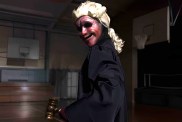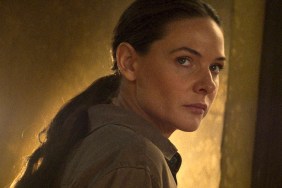Our retrospective series begins here!

No one trick or treats on the last day of school, no one carves jack o’ lanterns on July 4th, or goes on haunted hayrides in August.
When it comes to beloved macabre traditions, the fall is the season that gets all the attention. Thanks to the celebration of Halloween, the autumn months have always been indelibly associated with all things frightful. Summer, on the other hand, is ostensibly all that horror isn’t about â a golden time of warm weather, trips to the beach, fireworks, road trips and family picnics.
For those movie buffs that prefer the inside of their neighborhood cinemas (or, for some, the nighttime chill of drive-in theaters) to the blistering heat, however, the summer is the real witching season. Some believe that horror vacations in summer, waiting for fall to arrive, but box office history tells a different story.
Starting in 1975 when Jaws invented the modern blockbuster by teaching a generation to be afraid of the ocean, summer has been the best time of year to be scared. The fall can keep Halloween. It can keep the costumes, the candy, the Great Pumpkin, all of it â because summer has always had the better movies.

In the summer of 1979, only one horror movie really hit home for me. Even though ’79 was the summer of classics like Dawn of the Dead, Alien, and Phantasm (Newsweek magazine dubbed it “Hollywood’s Scary Summer” in their June 18th cover story that year), the movie that freaked me out the most was The Amityville Horror. Mind you, I was too young at the time to actually see any of these movies. But being exposed to the TV ads, to the posters, as well as to the talk of adults and friend’s older siblings convinced me that The Amityville Horror was something I needed to be worried about. Why? Because it was all true, that’s why.
I wasn’t worried about zombies taking over the Earth – even as a kid, I knew that was clearly preposterous (ironically, I believe in the possibility of a zombie apocalypse a lot more now than I did then!). I also had no anxieties about being chased through a spaceship by an alien. And what was going on in Phantasm? Well, that was anybody’s guess. Had I actually seen any of these films back then, they would’ve surely fried my brain, but just to hear about them didn’t make me all that nervous. As a kid who spent a lot of time camping with his family, the ads for that summer’s tacky monster movie Prophecy – with its murderous mutant bear on the loose in the woods – did more to disturb me than any of those classics. But as scary as it looked in the commercials, I knew that the monster in Prophecy was some made-up thing. Whatever chased the Lutz family out of their Long Island home after just 28 days, however, that was real.

Before the movie came out, I was already uneasy about the events that took place at the address of 112 Ocean Avenue, Long Island. The paperback novel by Jay Anson was everywhere upon its publication in 1977, with cover text boasting that it was “more hideously frightening than The Exorcist because it actually happened!” and on later printings, “A True Story” was found in big, bold letters under the title. Looking back, it seems ridiculous that anyone took stock in the tale of the Lutz’s ordeal but if so many adults were gullible enough to buy into this “true story,” I can’t blame myself as a kid for finding it plausible, too. Hell, at that time I had barely stopped believing in Santa Claus!
I had already encountered many a ghost story in movies and books prior to The Amityville Horror but this was the first one that made a real impact on me. Besides the promise that it was real, just the fact that it was a contemporary story made a difference. This wasn’t some old black and white movie like The Uninvited (1944), this was happening right now, to regular people. Also, The Amityville Horror was the first story of its kind (that I knew of, at least) to get demonic about its haunting. What happened to the Lutz family wasn’t even really a ghost story per se. This wasn’t The Amityville Haunting, it was The Amityville Horror (in titling his book, Anson was reportedly inspired by Lovecraft’s “The Dunwich Horror”).
The details I heard second-hand about The Amityville Horror had nothing to do with the familiar ghost story trappings of wispy apparitions seen floating down halls; instead it was about infestations of flies, about red eyes glowing in the window, about invisible pigs, and about a hidden “red room” behind a wall in the basement. How could I be expected to keep my cool after hearing about all that?

I knew the reviews for the movie hadn’t been good but the word from people who saw it said otherwise. The Amityville Horror was one of those movies that had an aura about it. Of course, back before everyone had cable and before VCRs were a common household item, it was much easier for films to seem larger than life. Now that movies can be bought or rented out of vending machines at the supermarket just a few months after they’ve played in theaters, movies can’t develop the same mystique that they used to; they’re too disposable. People can download films to their phones now, for crying out loud. Back in the day, though, if you were too young to see horror movies in the theater, these movies became mythic in your imagination as you waited as long as several years for them to arrive on network television. The actual films didn’t always live up to that imagined version, however, and that’s definitely the case with The Amityville Horror.
By the time I finally watched the movie sometime in the mid-’80s, I regarded it as a disappointment. No one would be fool enough to diss composer Lalo Schifrin’s Oscar-nominated score and overacting doesn’t come any better than Rod Steiger’s hysteria-prone performance as Father Delaney (and it may expose my juvenile sense of humor, but count me in as a fan of the nun who has to flee the house, peel away in her car, pull over to the side of the road and violently retch) but the mundane direction of Stuart Rosenberg is more suited to a TV movie. There’s no atmosphere to be found, the big scares are laughably meager (the red eyes outside the bedroom window look like a couple of twinkling Christmas lights) and Rosenberg isn’t helped any by screenwriter Sandor Stern’s flat adaptation of Jay Anson’s novel. I believe that if the film had come along even a year or two later, it would’ve been just another B-movie and not a phenomenon.

The fact remains, though, that it was a huge phenomenon. For whatever reason, the summer of ’79 was just the right time for The Amityville Horror. It’s likely that Stephen King correctly pegged the underlying reason for the film’s popular appeal in the financially fraught late ’70s as he noted in his non-fiction book “Danse Macabre” that the film’s subtext is one “of economic unease.” Watching the movie today, in the midst of another long, harsh season for the American economy, there’s a renewed resonance to George Lutz’s anger as a stretched-beyond-his-means businessman, homeowner, and family man who’s helplessly watching his world – and more specifically, his checking account – implode. Like too many Americans then and now, Lutz is someone who is finding that he can’t keep up with his bills, that he’s living outside of his income, and the prospect of losing everything unravels him. When he screams at one point, “God damn it – this is MY house!” it’s the frustrated cry of someone more afraid of the bank stepping in to repossess his property than he is of being possessed by evil spirits.
Social subtext aside, if there’s one thing that The Amityville Horror will always be remembered for, it’s the house itself – arguably the most instantly identifiable edifice in horror history with its Dutch gambrel roof design and quarter-circle windows that give it the appearance of having two evil eyes. To this day, no other haunted house can compare. As James Brolin’s Geroge Lutz says, “houses don’t have memories” but as The Amityville Horror proves, houses themselves can be unforgettable.
Read on for Ryan’s thoughts on Phantasm
Dawn of the Dead (May 24th)
Alien (May 25th)
Prophecy (June 15th)
Nightwing (June 22nd)
Dracula (July 20th)





Source: Jeff Allard









